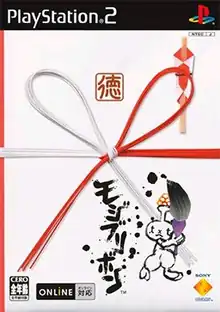| Mojib-Ribbon | |
|---|---|
 | |
| Developer(s) | NanaOn-Sha, Ltd. |
| Publisher(s) | SCEI |
| Producer(s) | Masaya Matsuura |
| Designer(s) | Masaya Matsuura |
| Artist(s) | Kiri Matsuura |
| Writer(s) | Seiko Ito |
| Composer(s) |
|
| Platform(s) | PlayStation 2 |
| Release |
|
| Genre(s) | Music |
| Mode(s) | Single-player, multiplayer |
Mojib-Ribbon (モジブリボン, Mojiburibon) is a 2003 music video game created by Masaya Matsuura as a spin-off[1] of his 1999 music game, Vib-Ribbon, which was released for PlayStation. A direct sequel called Vib-Ripple was released in 2004. The releases are comparable to the releases of the earlier PaRappa series (also a Matsuura series) where the original was followed by a pseudo-sequel and then a direct sequel a few years later.
Whereas in Vib-Ribbon the gameplay centered on the player's interaction with the melody of the song being played, in Mojib-Ribbon the gameplay centers on the player's interaction with the lyrics. As such, the music employed in the game is heavily lyrics-oriented rap music. The game's art-style is centered on traditional sumi-e and Japanese kana calligraphy.[2] This has led to claims that the game is incomprehensible to non-Japanese audiences, however the simplicity of gameplay have allowed numerous import gamers (typically also fans of Masaya Matsuura's works) to enjoy the game as well,[3] and guides exist online regarding menu navigation instructions for non-Japanese speakers.
Gameplay
In Mojib-Ribbon, the player plays the part of Mojibri (モジブリ, Mojiburi) (a name similar to that of Vibri from Vib-Ribbon), a character drawn in the sumi-e style who wishes to become a famous rapper (similar to PaRappa the Rapper) and to find the truest rap of them all.[4] In each level, Mojibri walks around a circle of clouds as rap lyrics written in kana pass underneath. The player must press up on the joystick to get Mojibri to dip his fude in the suzuri and then down to get Mojibri to write the kana as he sings it. The songs are heavily rhythm-based raps, and the player must time the application of the fude to the washi during lyrics and to the suzuri during breaks.
Later in the game Mojibri is joined by a female friend named Mojiko (モジコ) and a huge robot called Osorezan 1999 (オソレザン一九九九, Osorezan ichikyūkyūkyū). These characters have individual calligraphy styles.
Development
Mojib-Ribbon was initially teased as Vib-Ribbon 2 before being revealed at the 2002 Game Developers Conference.[5] Masaya Matsuura and J-pop band Laugh and Peace returned from Vib-Ribbon to compose Mojib-Ribbon's music, with the lyrics written by Japanese rap pioneer Seiko Ito.[6][7][8] Mojib-Ribbon was originally planned to be released in Europe, with Matsuura also working to get it published in America.[9][10]
See also
- Ōkami, a 2006 video game done in the Ink and wash painting (sumi-e) style
References
- ↑ Mojib Ribbon Archived 2009-03-16 at the Wayback Machine. MobyGames. Retrieved 28 November 2008.
- ↑ Gifford, Kevin. Mojib Ribbon (PS2). 1UP.com. Retrieved 28 November 2008.
- ↑ Mojib Ribbon - review Archived 2008-12-03 at the Wayback Machine. NTSC-UK. Retrieved 28 November 2008.
- ↑ Mojib Ribbon Archived 2008-08-22 at the Wayback Machine. IGN. Retrieved 28 November 2008.
- ↑ "Vib Ribbon 2 confirmed for development". The Gaming Intelligence Agency. January 17, 2002. Archived from the original on October 11, 2021. Retrieved October 10, 2021.
- ↑ Mojib-Ribbon instruction manual. Sony Computer Entertainment. 2003. p. 32.
- ↑ "松浦雅也氏、いとうせいこう氏が『モジブリボン』をお披露目" [Masaya Matsuura and Seiko Ito unveil "Mojib-Ribbon"]. Famitsu (in Japanese). October 9, 2003. Retrieved October 10, 2021.
- ↑ "『モジブリボン』のオリジナルサウンドトラック発売!" [Original soundtrack for "Mojib-Ribon" released!]. Famitsu (in Japanese). February 24, 2004. Retrieved October 10, 2021.
- ↑ Perry, Douglas C. (March 24, 2004). "GDC 2004: MojibRibbon". IGN. Archived from the original on October 11, 2021. Retrieved October 10, 2021.
- ↑ Maragos, Nich. "Mojib-Ribbon preview". The Gaming Intelligence Agency. Archived from the original on April 1, 2022. Retrieved October 10, 2021.